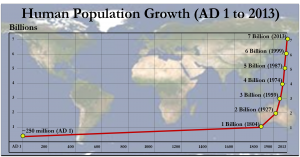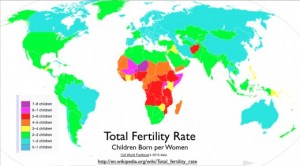According to the World Population Clock, there are almost 7.5 billion people living on the planet today. This number continues to increase at rapid rates, as death rates are dwarfed by birth rates. Only 200 years ago, the population was one billion, approximately seven times smaller, as stated in Geohive. Likewise, it is predicted that the population will surpass 10 million by 2100.

The population is growing at an exponential rate. Photo credit: http://www.evidenceunseen.com/articles/prophecy/overpopulation/
The growing population can be linked to several main sources. To begin with, medicine has been improving significantly in recent years. Although this has proved very beneficial to many individuals, it is caused a decline in death rates but had little to no impact on birth rates. Within poorer nations and among poorer individuals within a country, population growth has been rooted in poor family planning. Many people from developing countries are either unable to access contraceptives or in many cases even unaware of them. This is especially problematic as child mortality rates have gone down, because originally these would offset the effect of having a large number of children. Furthermore, in places where child labor is common, having extra hands to work can be beneficial, encouraging people to have large families. The rapidly growing population is likely to put increasing strain on the environment in coming years. Overpopulation is an alarming trend that exacerbates already existent environmental issues.
To begin with, as the population grows, people tend to move further into lands that once provided habitats for numerous different species, placing malls where forests once stood or houses where grasslands were present. This places the survival of many species in jeopardy. The Center For Biology Diversity describes the natural rate of extinction of species as one per year for every million species. Alarmingly, the rate is currently close to 30,000 per year per million species. This suggests that mankind could be moving towards yet another mass extinction, as increasing human numbers forces resources that once belonged to a large variety of species to be redirected.

Overpopulation is most prevalent in many developing nations. Photo credit: http://hubpages.com/politics/Population-Phobia-Has-the-Global-Population-Bomb-gone-Bust
Not only are other species impacted by the growing population, but much of the human population suffers in a similar manner. Unfortunately, many of the countries where overpopulation is most prevalent are those which already have trouble finding access to enough food, clean water, and other necessities. A Harvard study showed that 97 percent of the population increase in the next forty years will occur in developing countries, with 49 percent in Africa alone. This population growth is expected to contribute to declining life expectancies, likely attributed to the progressively increasing difficulty to get proper nutrition and clean water. Similarly, the Scientific American discusses how an increasing population can put people at greater risk from infectious diseases. Not only are people more susceptible because they have greater contact with other people, but diseases themselves are emerging and evolving faster. More people provide more opportunities for disease causing organisms to jump from another species to humans or simply evolve from a harmless microorganism to a pathogen. Between 1940 and 2004 alone, 300 new infectious diseases became prevalent.
Another point of concern has become the increasing amounts of pollution that contribute extensively to global warming and climate change. Although there have been significant efforts around the globe to encourage people to reduce their ecological footprint, the growing population tends to offset these efforts. Greenhouse gases are building up in the atmosphere at a rapid and alarming rate that is not showing significant signs of declining. At the same time, the increasing use of the fossil fuels contributing to Global Warming are also posing a problem as natural resources are used up. This extends even beyond fossil fuels to necessities like fresh water. Although much of the earth is water, only a miniscule fraction of that water is drinkable, something that is a large concern in many developing nations and will likely become a larger issue in the years to come.
The threat of overpopulation makes it clear that some form of action needs to be taken in order to prevent the population size from getting out of control and beyond what our planet can sustain. One of the best ways to prevent overpopulation would be working to improve education and awareness in relation to overpopulation for people from poor families and poor countries. It is critical that people are given information about birth control methods and family planning. This is especially important to preventing unplanned pregnancies, which account for about 40 percent of all pregnancies worldwide, according to the National Center for Biotechnology Information. Not only is it important that people are given information about ways to prevent unwanted pregnancies, but it is equally crucially that these are easily accessible to all individuals. The impacts of overpopulation could significantly lower quality of life for many if this issue is not brought under control; however, if measures are taken it is highly possible that these consequences could be avoided.
I knew overpopulation was becoming more important as an issue, but I had no idea that is was escalating so quickly. So, I guess you’re right about people needing to be more aware. And I agree that we need to be taking other species into consideration if they are going extinct at such a high rate.
This is not something I realized was such a problem until now. The culture we are surrounded by makes it feel like the number of births is decreasing. With women who don’t want children becoming more accepted by society, I had the feeling that population would start to plateau soon. Now I see why that is so inaccurate. The graphic you included of the world map was really eye opening. Though high birth rates aren’t something we are used to because of our culture, that doesn’t mean it is that way everywhere. It makes sense, that in poor places, more kids allows you more laborers to support you. This is a sad reality and makes me worry about how this problem will develop in the future.
Re: “…Only 200 years ago, the population was one billion, approximately seven times smaller, as stated in Geohive. Likewise, it is predicted that the population will surpass 10 million by 2100…”
Please correct “10 million” to “10 billion” with a “b”. 😉
Also:
World population projected to reach… 11.2 billion in 2100:
https://www.un.org/en/desa/world-population-projected-reach-98-billion-2050-and-112-billion-2100
Globally, human births still are significantly outpacing human deaths:
https://www.worldometers.info/